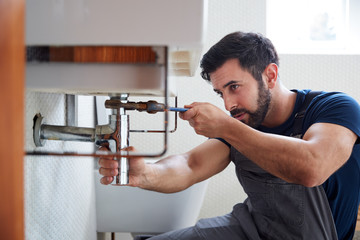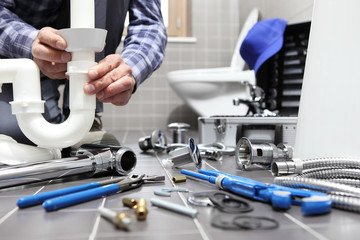Bathroom plumbing consists of pipes that run in the walls or underneath the sink cabinet. These pipes carry water to fixtures such as sinks, toilets, and showers. Older homes may have used different pipes, but modern piping materials are more durable and less likely to leak or crack. If you have a crack in your bathroom pipe, it is essential to turn off the water supply and check for other signs of water damage.

Bathroom plumbing systems also require proper venting. They are venting forces air into the pipes, releasing the additional air. If not, the wastewater will not drain properly and can cause a water lock. Water locks if the vents are obstructed, which is not recommended. You can hire Plumber to fix the problem for you.
The water supply to a bathroom is typically from a private well or a main city line. The main water supply line is usually located in the crawlspace or basement. It is connected to a shutoff valve near the water meter. The bathroom water supply pipes branch off the main water supply pipe. The cold water pipes carry water directly to the fixtures, while the hot water pipes pass onto a water heater. The water heater’s water is channeled back into the bathroom beside the cold water pipes. The wastewater from the bathroom passes from the house through the sewer line and is taken to a treatment facility.
The pipes for bathroom plumbing go through the wall studs. When installing new fixtures, you must ensure you measure properly before you begin. Getting the rough-in measurements right is a key step that makes up 90 percent of the plumbing installation process. Most fixture manufacturers will provide rough-in specifications in their product literature. For example, a 12-inch toilet will require a total distance of 12 1/2 inches. This distance is necessary to ensure proper installation and prevent problems later on.
The main drain line travels through the wall of the first floor and down to the basement or crawlspace. It may also be connected to a nearby drain line. This connection can be difficult if the drain line is smaller than 4 inches. When you install a new sink, you should connect the drain line to the sink.
Slow-draining sinks are a common plumbing issue. A clogged pipe or obstruction can cause the sink to drain slowly. Keeping the drain clear of debris will prevent costly plumbing repairs. You can also use a manual plumber snake to clear any blockage further down the line. However, it is still best to call a plumber to fix the problem. A plumbing technician can solve this problem quickly and easily, and make it a smooth process for you.
Toilets and sinks often cause clogs, especially when using soap and toothpaste. To prevent these clogs, a plumber can remove any debris and restore the drainage in your sink. A skilled technician can also install a new sink or repair a damaged one. Regardless of the cause, a professional plumber can help you maintain your bathroom plumbing with regular inspections.
Before you start any plumbing job, test the main shutoff valve to prevent flooding and other potential problems. It’s also important to know where the main water shutoff valve is located, as well as the types of pipes in your home. Most sinks have a shutoff valve located near the sink, which allows you to perform repairs safely without turning off the water supply to your entire house.
Many people are put off by bathroom remodel plumbing because they assume that professional plumbers know more about remodeling than they do themselves. If you want to hire a professional plumber for the job, make sure you check their credentials first. They must have the right accreditation and licenses. A good plumber should have at least a decade of experience in plumbing. He should have successfully completed several jobs with a reputable company. Also, before you allow them to start working on your bathroom remodel, you should find out how much they will be charging for the plumbing services that they will provide.



